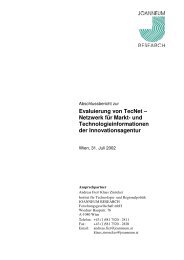roadMAP [PDF, 1.9 MB] - fteval
roadMAP [PDF, 1.9 MB] - fteval
roadMAP [PDF, 1.9 MB] - fteval
Create successful ePaper yourself
Turn your PDF publications into a flip-book with our unique Google optimized e-Paper software.
We assume that innovation networks arrange the required reciprocal linking of heterogeneous<br />
information and knowledge stocks as well as complementary resources better than hierarchic or<br />
market steering alone. Research and innovation networks are thus an institutional answer to<br />
heightened challenges in technology competition 5 .<br />
Policy makers and innovation researchers have found also other reasons to come forward with<br />
Multi Actor – Multi Measure programmes. Such reasons are of course closely related to the<br />
above mentioned innovation system and Mode II approaches (Stampfer 2003a):<br />
• Inclusion of new actors like innovative SMEs, the demand side (Arnold et. al. 1996) or public<br />
agencies from different sector policies like education, transport or environment into funding<br />
activities (Lundvall 2002);<br />
• Securing interconnected long-term funding of project clusters without setting up new<br />
institutions;<br />
• Integration of multi- and interdisciplinarity, as many MAPs address applied research needs<br />
for industry – and most of these challenges can only be met by approaches combining<br />
different disciplines and competences.<br />
4.2.2 Is it possible to create innovation networks 6 politically?<br />
Innovation networks have a number of challenges for policy makers. They are of high<br />
importance for the functioning of innovation systems. Public actors can do a lot to ease birth<br />
and life of such networks: Awareness raising, partner search, building trust and a shared<br />
knowledge base, network organisation, provision of complementary resources and active<br />
cooperation can be typical public roles (Polt 2001). It would lead too far to analyse all these<br />
factors here but two questions seem to be central:<br />
A first question in this respect regards equality versus dominance: If the principal economic<br />
policy regulatory question, whether the emergence of innovation networks should as a rule be<br />
left up to the self-organising powers of the innovation system, is answered with no, then the<br />
next question is, how should public promotional activities look like? A possible dilemma of public<br />
promoters can be that in Multi Actor arenas according to their self-conception they are the first<br />
among equals, in a network concept – and sometimes in reality – however only equal among<br />
equals (Kuhlmann 1998). As research on industrial districts, i.e. regionally anchored innovation<br />
networks shows (Crouch et. al. 2001), networks cannot be commanded, but are the product of a<br />
complex development process.<br />
5<br />
Note that for us, Competence Centres are conceptualised as a form of an innovation network, though in some<br />
cases such Centres have to be set up forming a legal entity of their own. However, network characteristics<br />
such as non-hierarchical forms of communication, cooperation and decision within the competence centres are<br />
dominant.<br />
6 Note that also the creation of physical Cooperative Centres is to be understood as a measure to strengthen<br />
innovation networks of a multitude of different actors.<br />
<strong>roadMAP</strong> 17


![roadMAP [PDF, 1.9 MB] - fteval](https://img.yumpu.com/21079876/22/500x640/roadmap-pdf-19-mb-fteval.jpg)

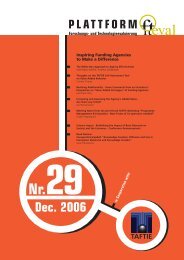
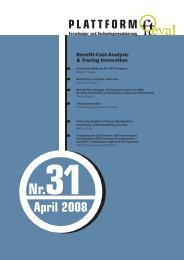
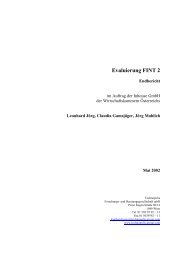
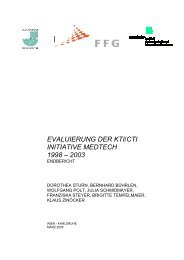
![GuggenbergeronBoku [PDF, 73.4 KB] - fteval](https://img.yumpu.com/21024081/1/184x260/guggenbergeronboku-pdf-734-kb-fteval.jpg?quality=85)
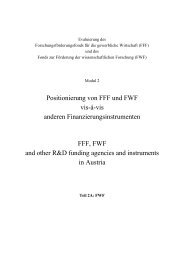

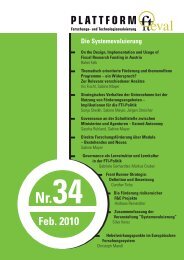
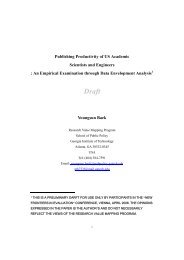
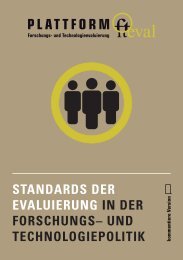
![ITF_Energietechnik [PDF, 39.6 KB] - fteval](https://img.yumpu.com/20959076/1/184x260/itf-energietechnik-pdf-396-kb-fteval.jpg?quality=85)
![Evaluation Standards [PDF, 120.8 KB] - fteval](https://img.yumpu.com/20931509/1/184x260/evaluation-standards-pdf-1208-kb-fteval.jpg?quality=85)
